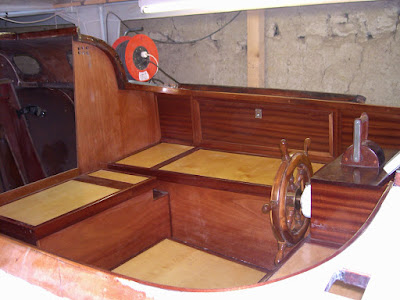The cockpit was a mess. The little bit of rot in one corner grew as the material continued to crumble beneath my fingers until I realized that the whole cockpit structure including both bulkheads fore and aft had to be rebuilt. I first removed all the fastenings possible. The heads of most of the screws I tried to remove had disintegrated and I found that all the patent methods of removal I tried were not practical either in terms of time or due to the damage they caused to the surrounding material. So I used my apple core method: I used the smallest hole saw, 14mm, with the pilot drill removed and the drill held in a mobile drill stand to keep it vertical and steady. I then removed a core with the screw in it and plugged the hole with a hard or softwood dowel set in thickened epoxy. If the hole was cut in a finished piece as in the shear strake, I inset the dowel far enough that a 15mm hardwood plug could be used to finish it.
Using the Fein multitool with assorted cutting heads, I cut out whole sections and as the cut was so fine I was able to use them as accurate templates.
Both bulkheads as well as most sections of the cockpit were removed in this way and saved me a great deal of time and sorrow.
 The Atalanta rudder is controlled by cables running over sheaves around the aft cabin, leading to a bearing shaft through the aft cockpit bulkhead to a whipstaff tiller. The bearing, of course, was seized. Faced with machining a new bearing I looked at alternatives and decided that with the centre cockpit my logical choice was hydraulic wheel steering. I have hands-on experi-
The Atalanta rudder is controlled by cables running over sheaves around the aft cabin, leading to a bearing shaft through the aft cockpit bulkhead to a whipstaff tiller. The bearing, of course, was seized. Faced with machining a new bearing I looked at alternatives and decided that with the centre cockpit my logical choice was hydraulic wheel steering. I have hands-on experi-ence with most systems and concluded that, even with the limitations, it was the way for me to go.

The diesel motor had to go, even though it had just been rebuilt. Local regulations prohibit IC motors on all but service vessels on many recreational inland waters in Europe. So it’s sails, oars or an electric motor. Even the luxury of a hybrid that is a diesel with an electric motor, is denied. The installation of an electric motor and a large battery bank changed the design criteria of the engine room space and the cockpit. Access to the sensitive electrics and electronic controls was required from the aft cabin while access from the cockpit sole was substantially reduced.

I have always liked bridge decks. It makes a smaller target for rogue seas, creates a comfortable seating arrangement and working space as well as usable space below decks. So, to me, they appeared to be a logical progression following the changes required by the engine refit.
There is never enough storage space in the cockpit and as I considered the pilot berth under the chart table and starboard cockpit seat impractical, I decided to build port and starboard cockpit lockers. I have designed them to be watertight. I hope they remain so. The working surfaces which are the lighter coloured areas will be finished at the end of the project with 6mm teak decking caulked with sikaflex.


I had many misgivings about diverging from the original design and feel that there are many who will disagree with my decisions, but I like and stand up for what I have done and had lots of fun building it.
 | ||
| Varnish, teak-oil and sunshine |
 | |
| Fridge under fwd. bridge deck |
 | |
| Cream coloured decks with non-skid |
 | ||
| Original Agba deckhouse |
 |
| All hatches are original |
 | |
| Hatches refastened and epoxy glued, sapelli veneered and finished with 10 coats of Veneziani varnish |
 | |
| Solar panels |



No comments:
Post a Comment